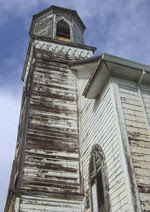This well known bar has the honor of being the first point on Yuba river, where gold was discovered. Jonas Spect, of Colusa, found gold at this point, June 2, 1848, but not in paying quantities, and went further down the stream. The next man we hear of at Rose Bar, was a Mr. Inman, later in June; Claude Chana, of Wheatland, came there a few days after. He says: - "I met a man named Inman, who came overland with me in 1846, just before I got to the bar. He said he had been working there a few days, but could only make five dollars per day and so left to find a better place." Chana, however, went on to the bar and commenced to work, and with five Indians, made one hundred and fifty dollars each the first day, at the same spot Inman had deserted. They simply dug a little deeper. This was the first actual working of the bar. In July, 1848, John Rose came to the bar with about a dozen men, from the American river. Accompanying the party was John Ray, with his wife and several children. This was the first family at the bar.
That fall John Rose and his partner, William J. Reynolds, started a store at the bar. Rose did the buying at Sacramento, and in that way the locality became known as Rose Bar. Jonas Spect had a store here, kept by Mr. McIlvain. Most of the company abandoned the place that fall, but others arriving, increased the number to twenty-five by the first of January, 1849. There had been heretofore room enough, and to spare. The miners were not confined to any particular location, but worked at any point that suited their fancy. When the miners began to arrive from the East, it became a little crowded, and in the spring of 1849 a meeting was held, at which it was decided that a claim should be one hundred feet square, and that the miner should be confined to his claim. Rose, Reynolds and Kinloch, a young man they had taken into partnership, furnished beef from their ranch in Linda township.
In September, 1849, a company of fifty men, among whom was William H. Parks, commenced to dam the river, so as to mine the bed. They completed the dam, and commenced work early in October. The rain set in on the eighth, and in two days the water overflowed the dam and washed it away. In the few days' work they had taken out one thousand dollars each. A few days before the destruction of the dam, Mr. Parks sold out, and with an experienced baker started a store, bakery, and boarding house. During the year the bar became very populous, and in 1850, there were two thousand men working here. At that time there were three stores, one of which was kept by Baker & States, three boarding houses, two saloons, bakeries, blacksmith shops, etc. The course of the river was turned seven consecutive years, the last time in 1857. But little work was done here after that, and now the bar is covered by tailings from the mines, many feet in depth. When the high water came during the winter of 1849, the miners moved back into the ravines, where they found very rich surface diggings. Squaw creek was a very rich locality.
from Thompson & West's "History of Yuba County" - 1879.
http://www.excelsiorproject.com/map/rosebar.php









